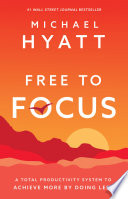

In today's fast-paced world, distractions are abundant, making it increasingly difficult to maintain focus on what truly matters. 'Free to Focus' emphasizes the necessity of honing in on our most important tasks and eliminating distractions that drain our productivity. The book argues that by prioritizing focus, we can achieve more meaningful work and ultimately lead more fulfilling lives. This idea is grounded in the understanding that our attention is a finite resource, and how we allocate it can significantly impact our performance and satisfaction. By learning to identify high-value tasks and dedicating uninterrupted time to them, readers can enhance their productivity and creativity.
Continue readingOne of the core themes of 'Free to Focus' is the power of saying no. The author discusses how taking on too many commitments can lead to burnout and decreased productivity. By learning to say no to tasks and projects that do not align with our goals, we free up time and energy for what truly matters. This concept encourages readers to evaluate their commitments and make conscious choices about where to invest their time. The book provides practical strategies for politely declining requests and setting boundaries, which can lead to a more focused and productive life.
Continue readingEffective planning is essential for maintaining focus and achieving goals. 'Free to Focus' introduces readers to various planning techniques that can help streamline their work processes. The author emphasizes the importance of setting clear objectives and breaking them down into manageable tasks. By creating a structured plan, individuals can prioritize their activities and allocate their time more efficiently. The book also highlights the value of regular reviews and adjustments to ensure that plans remain aligned with changing priorities and circumstances.
Continue readingThe author introduces the concept of the 3 D's of productivity: Do it, Delegate it, or Dump it. This framework helps readers assess their tasks and make informed decisions about how to handle them. 'Do it' refers to tasks that require personal attention and should be completed by the individual. 'Delegate it' encourages readers to identify tasks that can be assigned to others, freeing up time for more critical responsibilities. Finally, 'Dump it' emphasizes the importance of recognizing tasks that no longer serve a purpose and should be eliminated altogether. This approach allows individuals to streamline their workload and focus on high-impact activities.
Continue readingDeep work is a state of focused, undistracted work that allows individuals to produce high-quality results in less time. 'Free to Focus' advocates for the cultivation of deep work habits, which are essential for achieving peak performance. The book provides strategies for creating an environment conducive to deep work, such as minimizing distractions and setting specific time blocks for focused tasks. By prioritizing deep work, readers can enhance their creativity, problem-solving abilities, and overall productivity.
Continue readingRest and recovery are often overlooked in discussions about productivity, yet they are crucial for maintaining long-term focus and performance. 'Free to Focus' emphasizes the need for regular breaks and downtime to recharge both mentally and physically. The author discusses the science behind rest and its impact on creativity and productivity. By incorporating rest into their routines, readers can prevent burnout and sustain high levels of performance over time. The book offers practical tips for integrating rest into daily schedules and encourages readers to view it as an essential component of their productivity strategy.
Continue readingThe environment in which we work significantly influences our ability to focus and be productive. 'Free to Focus' discusses the importance of creating a workspace that minimizes distractions and promotes concentration. The author offers practical advice on organizing physical and digital workspaces to enhance focus. This includes decluttering, using tools to block distractions, and establishing rituals that signal the start of focused work sessions. By designing an environment that supports focus, readers can optimize their productivity and achieve better results.
Continue reading